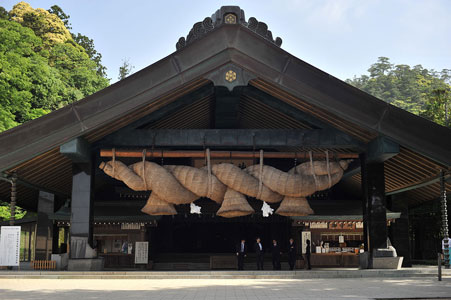
|
|

|
Hokusai - Ehon Sumida Gawa - Prints 3-12 and 3-13

|
|

|
In print 3-12 Shintō priests are tying a shimenawa to the torii gate of a shrine at San’ya (山谷, which translates into “mountain valley”) to ward off evil spirits. It was customary to do this as a preparation for the New Year.
Shimenawa (注連縄, literally meaning “enclosing rope”) are lengths of laid rice straw rope used for ritual purification in the Shintō religion. They can vary in diameter from a few centimeters to several meters, and are typically intertwined with all sorts of other materials. In print 3-12, for example, the shimenawa is intertwined with other pieces of rope, pine branches, and bird feathers. They are often also seen festooned with shide (紙垂, which literally translates into “paper appendices” and actually means “zigzag-shaped paper streamers”). A space bound by shimenawa indicates a sacred or pure space, such as that of a Shintō shrine.
Shimenawa are believed to act as a ward against evil spirits and are often set up at a ground-breaking ceremony before construction on a new building begins. They are found at Shintō shrines, torii gates, and sacred landmarks.
Here are some spectacular examples of Japanese shimenawa, one applied to the two sacred rocks called Meoto Iwa (married couple rocks):

|
and two at the entrance of shrines (Izumo Taisha shrine on the left and Suwa Taisha shrine on the right):

|

|
These two shrine shimenawa are the largest in Japan and each weighs several tons.
Here are three easily reproduced examples of shide:

|